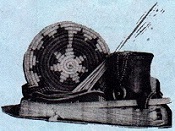Saad Bee Ál’íní (Alphabets)
A, B, Ch, Ch’, D, Dl, Dz, E, G, Gh, H, Hw, I, J, K, K’, Kw, L, Ł,
M, N, O, S, Sh, T, T’, Tł, Ts, Ts’, W, X, Y, Z, Zh, ’ (glottal stop)
|
|
Yá’át’ééh Marilyn Dempsey dashijní. Kiiyaa’áanii nishłí̜. Tó Dích’íi’nii báshíshchíín. Dibéłzhíní éí dashicheii. Hónágháahnii éí dashinálí. Kót’éego asdzá̜á̜ nishłí̜.

The Diné Bizaad page’s purpose is to provide an introduction to our indigenous language. Our language has been spoken by our people throughout time to communicate with one another, to sing, to pray, to express thoughts, and to think, plan, live, and reflect on our lives. Our great grandfather and leader, Chief Manuelito was quoted, “Shikéí, shidine’é, ałtah háási̜i̜łgóó… háadida léi’ nihizaad, nihisodizin, ádóone’é niidlínígíí dóó nihe’á’ál’í̜ nihił ch’aa wóle’ sha’áłchíní, hosídoolí̜i̜ji̜’, sidoołdee’ji̜’…” His words should not be forgotten and left by the wayside. So, it is up to each one of us to revitalize and maintain our dying language.
Indigenous languages have been utilized in wars of the United States. Our Diné language was used to win a war for this country. Just as the Code Talkers used our language as a weapon, we too must use our language as a weapon to protect our Diné Culture and values.
Diné Bizaad is one of the few indigenous languages left. We have not lost it all yet. Out of hundreds of indigenous languages pre-Columbus, there are less than 100 indigenous languages left that are spoken today.
Language is essential to the survival of a culture. Language and culture is essential to one’s self-identity, self-esteem, foundation, and success in life.
|
Haigo Níłch’i Ał’a̜a̜ Anáá’níłígíí
|
|
T’áá ákwíí jí̜ éí níłch’i ał’a̜a̜ anáá’nííł. Ninááhaiígíí daan dóó níléí haiji̜’ éí níłch’i ał’a̜a̜ anáá’nííł. Áko níléí Níłch’its’ósí dóó níléí Yas Niłt’eesji̜’ éí ayóo deesk’aaz łeh. Kohgo éí yas dahóló̜o̜ łeh dóó nídadíchíił łeh, Diné Bikéyah bikáá’góó. Índa hai haleehgo éí diłk’as.
Áko éí Diné haigo éé’ yee nidaakai ̜łeh. Éétsoh dóó lájish dóó ké’échogii da yee nidaakai łeh. Áádóó níłch’i éí sik’az yileehgo éí átsé nidahałtin łeh. Áádóó dadíchííł. Níléí Níłch’its’ósí biyi’ éí tó bił níchíil łeh. Éí ayóo ná’áłtłeeh. Áko ayóo dahashtł’ish łeh. Deesk’aazgo yéego níyolgo éí níló éí yoo’ nimazí nahalingo nanidéeh łeh. Níló łahda ádaałts’íísí łeh dóó łahda danitsaa łeh. Áko éí nílótsoh nááłtí̜í̜h. Áádóó łahda éí nílóyázhí nááłtí̜í̜h. Éí nahałtinígíí tingo k’ásdá̜á̜’ yasgo nááłtí̜í̜h.
Bikéé’dóó éí dadichííł. Átsé éí yas t’óó nahasáał łeh. Éí yas áłch’í̜í͔dígo t’áá hazhó’ógo náhindéeh łeh. Áádóó yéego diłk’asgo éí níchíił łeh. Łahda t’áá níchíilgo la̜’í yas nanidah. Áko éí yas yitsoh.
|
Yas yitsohgo éí t’áá hóyée’ łeh. Dibé dóó tł’ízí dóó béégashii dóó łí̜í̜’ da éí yéego baa áháyá̜a̜go t’éiyá yá’át’ééh. Háálá tł’oh dóó nanise’ ałtso bik’iichííł. Áádóó níléí yas biyaadi éí ni’ígíí hastin łeh.
Yas Niłt’ees biyi’ éí yéego dadeesk’aaz łeh. Hooghan ba̜a̜hdé̜é̜’ tin ba̜a̜hdi daaz’á̜a̜ łeh. Áko éí jí̜ atin łeh. Yas éí haashí̜í̜ nízahji̜’ ninályí̜í̜h dóó nátí̜í̜h. Áko yas bikáa’gi éí nitł’iz yileeh. Éí shí̜í̜ yas niłt’ees wolyé. Hódíina’dá̜á̜’ éí yas dajiłne’go yah adajiikaahgo dajiłhí̜i̜hgo tóhígíí dajidlá̜ dóó bee tá’ádazdigis nít’éé’. K’ad shí̜í̜ éí Diné doo ákódaat’í̜i̜ da.
Áádóó haigo éí naadá̜á̜’ ch’iyáán dahistiin wolyéego ádajił’í̜í̜ nít’éé’. Haigo hane’ Ma’ii jooldoshí dóó tł’óół bee na’atł’o’ dóó Hataa’ Baazhní’áázh baa dahane’. Kohgo éí naaldlooshii baa dahane’ígíí da’ałhosh. Áádóó nahaghá̜ Yé’ii Bicheii dóó Ił Náshjingo hatáál éí ádaal’í̜.
|
Haigo Níłch’i Ał’a̜a̜ Anáá’níłígíí
(Winter Weather)
|
|
Yas nahasááł – snow flurry
Tó bił níchííl – rain and snow mix
Yas – snow
Dadichííł – snow begins to fall
Níló – hail
Nílótsoh – big hail storm
Nílóyázhí – sleet
Níchííł – snowing
Yas yitsoh – big snow storm
Hastin – frozen ground
|

|
Saad Bóhoo’aah
|
Fill in the blank with the missing word. Practice using Diné words every day.
|
|
Yah nahasááł
|
Tł’óo’di __________. (There are snow flurries outside.)
|
|
Tó bił níchííl
|
Níłch’its’ósígo __________ łeh.
(Rain and snow mix usually falls in November.)
|
|
Yas
|
__________ sik’az dóó diłhí̜í̜h. (Snow is cold and melts.)
|
|
Dadíchííł
|
Hai haleehgo éí __________.
(Snow begins to fall when it becomes winter.)
|
|
Níló
|
__________ danímaz. (Hail is round.)
|
|
Nílótsoh
|
Yéego níyolgo éí __________ haleeh.
(There is a big hail storm when there is a big wind storm.)
|
|
Nílóyázhí
|
__________ éí nahałtingo yití̜i̜hgo haleeh.
(Sleet falls when rain freezes.)
|
|
Níchííł
|
Tł’óo’di __________. (It is snowing outside.)
|
|
Yas yitsoh
|
__________go éí hóyéé’.
(It is difficult when there is a big snow storm.)
|
|
Hastin
|
Haigo éí ni’__________ łeh.
(The ground freezes in the winter.)
|
|
